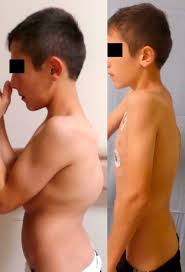Gibbus deformity is a form of structural kyphosis typically found in the upper lumbar and lower thoracic vertebrae, where one or more adjacent vertebrae become wedged.
Gibbus deformity most often develops in young children as a result of spinal tuberculosis.
It is the result of collapse of vertebral bodies, which can lead to spinal cord compression causing paraplegia.
Other possible causes of gibbus deformity include hereditary and congenital conditions, and physical trauma to the spine that results in injury.
Gibbus deformity may result from cretinism, mucopolysaccharidosis, and certain congenital syndromes, including achondroplasia.
Gibbus deformity with a higher-degree angle in the spinal curve include Pott’s disease and Scheuermann kyphosis, marked by an especially sharp angle.
A kyphosis of >70° can be an indication of the need for surgery.

